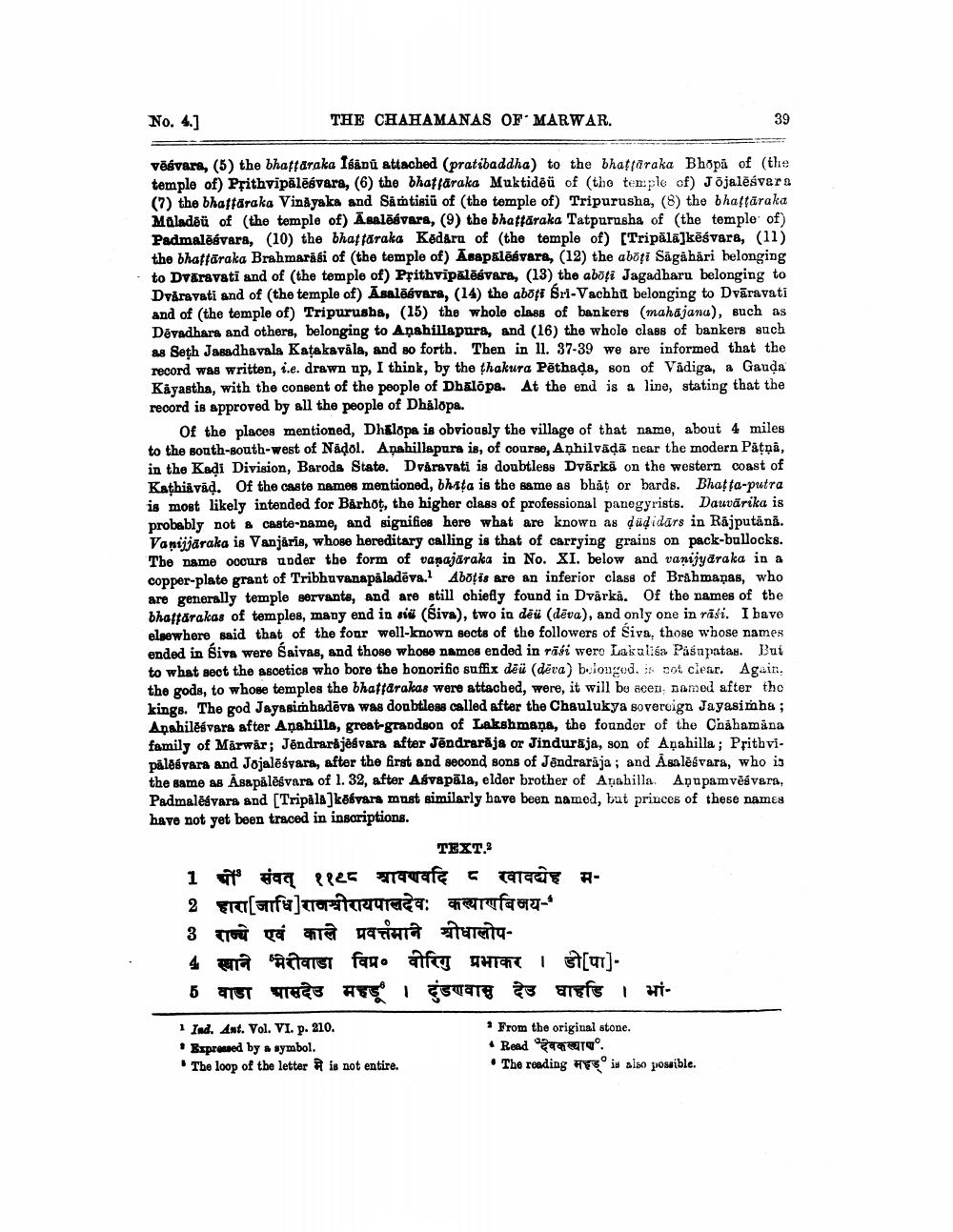________________
No. 4.]
THE CHAHAMANAS OF MARWAR.
39
vēsvara, (5) the bhattaraka Ifanű attached (pratibaddha) to the bhatjāraka Bhopā of (the temple of) Přithvipālēsvara, (6) the bhaffäraka Muktidēü of (the ten:ple of) Jõjalēśvera (7) the bhaftäraka Vinyaks and Säntisiū of the temple of) Tripurusha, (8) the bhaffäraka Maladēü of the temple of) Asalēsvara, (9) the bhattāraka Tatpurusha of (the temple of) Padmalēsvara, (10) the bhaffaraka Kadard of the temple of) [Tripälajkēśvara, (11) the bhattaraka Brahmaraki of the temple of) Asapalēsvara, (12) the aboti Sågåhäri belonging to Dvāravati and of the temple of) Prithvipalēsvara, (13) the aboți Jagadbaru belonging to Dvåravati and of the temple of) Asalāávara, (14) the abori Sri-Vachhu belonging to Dvāravati and of the temple of) Tripurusha, (15) the whole class of bankers (mahajana), such as Dévadhara and others, belonging to Anahillepara, and (16) the whole class of bankers such e Seth Jasadhavala Katakavala, and so forth. Then in 11. 37-39 we are informed that the record was written, i.e. drawn up, I think, by the thakura Pēthada, son of Vädiga, a Gauda Kiyastha, with the consent of the people of Dhalopa. At the end is a line, stating that the record is approved by all the people of Dhalopa.
Of the places mentioned, Dhalopa is obviously the village of that name, about 4 miles to the south-south-west of Nádol. Anahillapura is, of course, Anhilvädā near the modern Patņa, in the Kadi Division, Baroda State. Dväravati is doubtless Dvārkä on the western coast of Kathiảvad. Of the casto names mentioned, bhata is the same as bhåt or bards. Bhatta-putra is most likely intended for Bárhot, the higher class of professional panegyrists. Dauvärika is probably not a caste-name, and signifies here what are known as dudidars in Rajputanå. Vaniijāraka is Vanjäris, whose hereditary calling is that of carrying grains on pack-bullocks. The name occurs under the form of vapajāraka in No. XI. below and vanijyaraka in a copper-plate grant of Tribhuvanapaladēva. Aboțis are an inferior class of Brahmaņas, who are generally temple servants, and are still chiefly found in Dvärkä. Of the names of the bhaffärakas of temples, many end in sid (Siva), two in dëü (dēva), and only one in räsi. I bave elsewhere said that of the four well-known sects of the followers of Siva, those whose names ended in Śiva were Saivas, and those whose names ended in rāfi wero Lasalita Pasapatas. But to what sect the ascetics who bore the honorific suffix dēü (dēva) bulongod. is sot clear. Again. the gods, to whose temples the bhaffarakas were attached, were, it will be seen named after the kings. The god Jayasimhadēva was donbtless called after the Chaulukya sovereign Jayasimha; Anahilēsvars after Anahills, great-grandson of Lakshmana, the founder of the Chahamana family of Mårwår; Jendrarjeśvara after Jēndrarija or Jinduraja, son of Anahilla; Prithvi. pålēśvara and Jojalēśvara, after the first and second sons of Jêndrarāja ; and Asalēsvara, who is the same as Asa pälēśvara of 1.32, after Asvapāla, elder brother of Anahilla Anupamvēģvera, Padmalēgvars and [TripalA]kesvars must similarly have been named, but priuces of these names have not yet been traced in inscriptions.
TEXT. 1 पों' संवत् ११८८ श्रावणवदि ८ रवावधेह म2 r[urfa]Tropitarraraga: rifacy3 राज्ये एवं काले प्रवत्तमाने श्रीधालोप4 wa safaret fago afry AHTO I ST[UT]5 वाडा भासदेउ महडू । दुंडणवासु देउ घाडि । भां
1 Ind. Ant. Vol. VI. p. 210. • Expressed by symbol.
The loop of the letter is not entire.
. From the original stone. • Read देवकत्याप. • The reading #83 is siso possible




